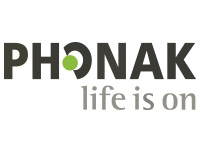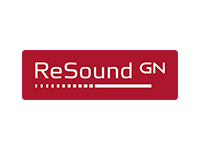
- Feb 10, 2020
Sudden Deafness
Updated December 2021
Most Hearing loss is acquired through recreational and workplace noise, illness, medications and as part of the process of ageing.
With an ageing population, hearing loss is predicted to increase to one in every four Australians by 2050. About a third of acquired hearing loss is because of noise exposure from workplace noise and leisure activities and is largely preventable. Hearing loss increases from less than one per cent for people younger than 15 years to three in every four people aged over 70 years.
Hearing loss can be congenital, meaning from birth, or occur as a result of a disease or accident. Some of the diseases that affect hearing include Scarlet Fever, Meningitis, Mumps and Measles. Traumatic skull or ear injuries, exposure to loud sounds, ear pressure problems incurred while scuba diving, etcetera, can lead to permanent full or partial hearing loss.
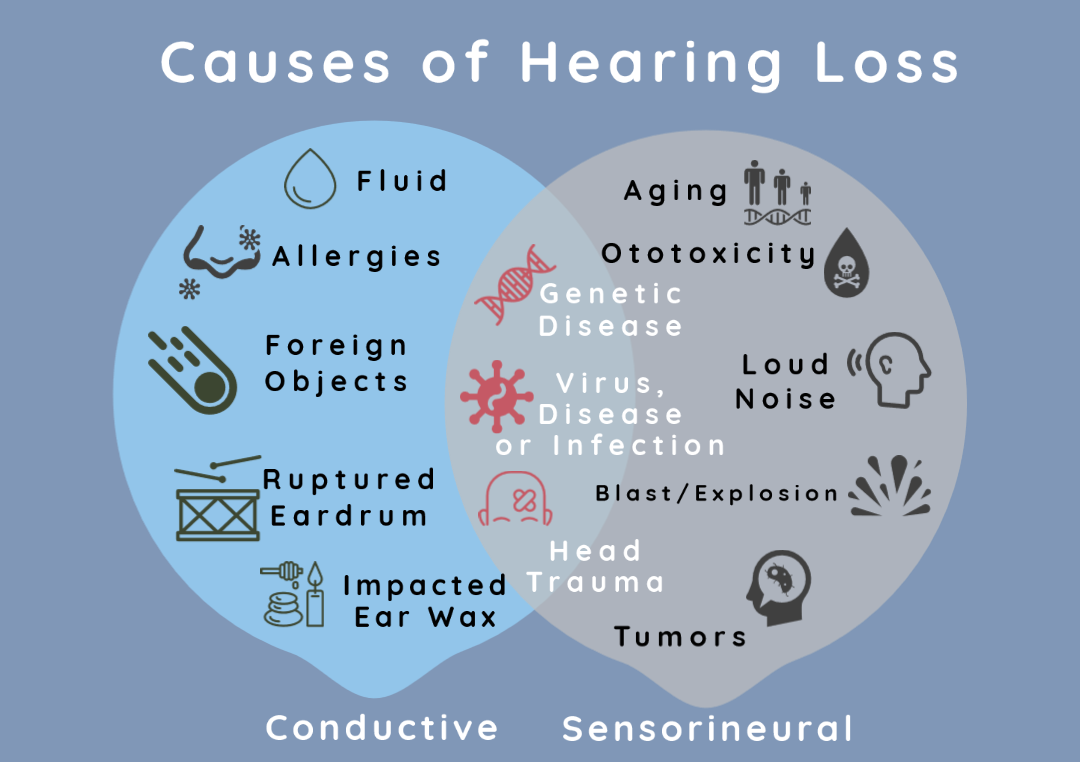 source: https://houghear.org/bhsm/
source: https://houghear.org/bhsm/
Hearing loss occurs in one of two areas: a conductive hearing loss, which is due to a mechanical problem within the outer or inner ear known as CHL. However, fluid accumulation is the most common cause of conductive hearing loss in the middle ear, especially in children.
Major causes of hearing loss are ear infections or conditions that block the Eustachian tube, such as allergies or tumours in next to the inner ear, which can lead to permanent sensorineural hearing loss. Sensorineural hearing loss (SNHL) is related to the tiny nerve cells in the inner-ear experiencing injury, disease or malfunction.
Temporary Hearing Loss
Noise causes sound waves that make our ear drums vibrate. These vibrations are received by hair cells in the inner ear, which flatten according to the frequency and loudness of the sound and stimulate nerves that pass messages to the brain.
Very loud sounds make the hair cells collapse and flatten temporarily, resulting in temporary deafness. This is referred to as a temporary threshold shift and may last hours or longer depending on the degree of noise exposure.
This temporary hearing loss may also be accompanied by a ringing sensation called tinnitus. If this severe noise exposure is repeated over many years, the hair cells in the inner ear become permanently damaged resulting in permanent hearing loss.
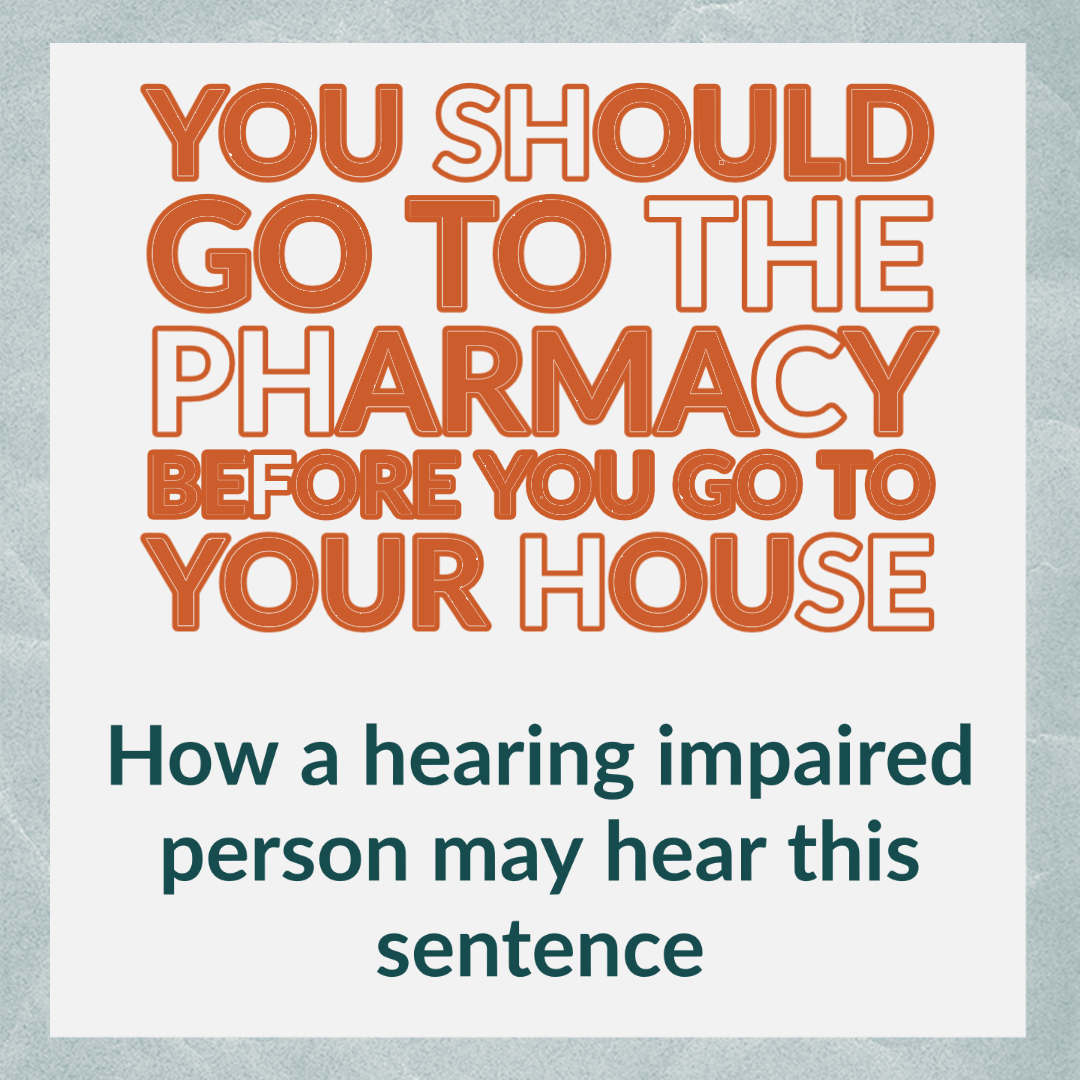
Permanent Hearing Loss
Noise-induced hearing loss occurs gradually over a long period of time and unfortunately, the hearing loss is permanent. Historically, noise-induced hearing loss is often due to unsafe industrial practices on construction sites or in factories and the music industry. Refer a Brief Hear-Story of Deafness
Sudden sensorineural (inner ear) hearing loss (SSHL), commonly known as sudden deafness, is an unexplained, rapid loss of hearing either all at once or over a few days.
Sometimes, people with SSHL put off seeing a doctor because they think their hearing loss is due to allergies, a sinus infection, earwax plugging the ear canal, the Eustachian tube being blocked or other common conditions.
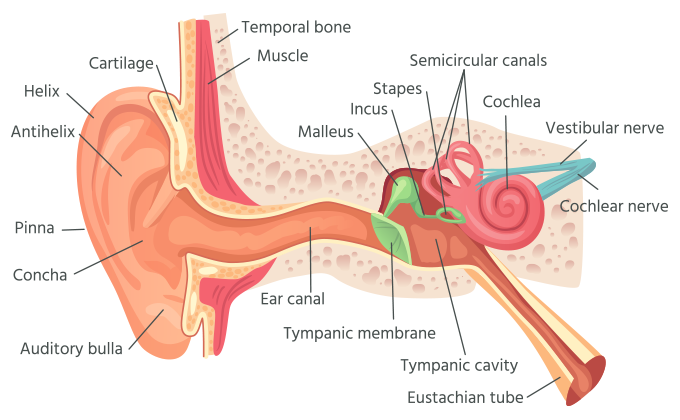
Sudden Sensorineural Hearing Loss
Sudden hearing loss is rare and usually occurs in one ear. However, sudden hearing loss should be considered a medical emergency and attended to by a hearing medical expert immediately - Ear, Nose & Throat (ENT) specialist.
Sudden hearing loss can strike at any age, but it is most common in people who have reached their fifties. It is estimated that 5-160 people per 100,000 each year suffer sudden sensorineural hearing loss in Australia.
Although the hearing loss seems to strike suddenly—as when a patient experiences a sudden pop and hearing is gone—in actuality, as patients look back, some recall fluctuating ear symptoms: tinnitus (noises in the ear); transient hearing loss; or dizziness for a week or two before the SSNHL really hits. Earache is not a common symptom of sudden hearing loss.
If a sudden sensorineural hearing loss is diagnosed and treated within 24 - 72 hours of onset, the odds of all or some of the hearing returning are best achieved through treatment with strong steroid medication.
Of the patients who are prescribed steroid medication within the first 24 - 72 hours of the hearing loss, less than 60% get full or partial restoration of their hearing.
Some experts attribute sudden hearing loss to an impaired blood supply through a tiny artery into the cochlea of the inner ear.
ENT specialists do not know the specific reasons for an individual's SSHL but it might be related to unknown viruses or stroke. A stroke in the region of the temporal lobe will usually result in a mild hearing loss if the damage is confined to one temporal lobe. While it is uncommon both temporal lobes can be affected by a stroke, resulting in complete deafness.
In rare cases, hearing loss occurs when a benign tumour grows between the inner ear and the brain, but there is no known cause for these tumours and they are not known to run in families.
While damaged auditory hair cells can be compensated for with the use of hearing aids, there is no replacement or cure for damaged vestibular hair cells. Hair cells do not function in isolation, but need to be connected to the auditory centres of the brain through nerve fibres.
A hearing loss of up to 20 decibels below the hearing threshold is still considered to be normal hearing. More severe hearing loss can be described according to severity, as follows:
- Mild hearing loss: Hearing loss of 20 to 40 decibels.
- Moderate hearing loss: Hearing loss of 41 to 60 decibels.
- Severe hearing loss: Hearing loss of 61 to 80 decibels.
- Profound hearing loss or deafness: Hearing loss of more than 81 decibels.
Description |
Range |
|
| Normal | Normal hearing | 0-19 dB |
| Mild | Has great difficulty hearing and understanding another person talking in a noisy place (eg, on an urban street) | 20-34 dB |
| Mild with ringing | Has great difficulty hearing and understanding another person talking in a noisy place (eg, on an urban street), and sometimes has annoying ringing in the ears | 20-34 dB |
| Moderate | Is unable to hear and understand another person talking in a noisy place (eg, on an urban street), and has difficulty hearing another person talking even in a quiet place or on the telephone | 35-49 dB |
| Moderate with ringing | Is unable to hear and understand another person talking in a noisy place (eg, on an urban street), and has difficulty hearing another person talking even in a quiet place or on the telephone, and has annoying ringing in the ears for more than 5 min at a time, almost every day | 35-49 dB |
| Moderately severe | No lay description available | 50-64 dB |
| Moderately severe with ringing | No lay description available | 50-64 dB |
| Severe | Is unable to hear and understand another person talking, even in a quiet place, and unable to take part in a telephone conversation; difficulties with communicating and relating to others sometimes cause emotional effects (eg, worry or depression) | 65-79 dB |
| Severe with ringing | Is unable to hear and understand another person talking, even in a quiet place, and unable to take part in a telephone conversation, and has annoying ringing in the ears for more than 5 min at a time, almost every day; difficulties with communicating and relating to others sometimes cause emotional effects (eg, worry or depression) | 65-79 dB |
| Profound | Is unable to hear and understand another person talking, even in a quiet place, is unable to take part in a telephone conversation, and has great difficulty hearing anything in any other situation; difficulties with communicating and relating to others often cause worry, depression, and loneliness | 80-94 dB |
| Profound with ringing | Is unable to hear and understand another person talking, even in a quiet place, is unable to take part in a telephone conversation, has great difficulty hearing anything in any other situation, and has annoying ringing in the ears for more than 5 min at a time, several times a day; difficulties with communicating and relating to others often cause worry, depression, or loneliness | 80-94 dB |
| Complete | Cannot hear at all in any situation, including even the loudest sounds, and cannot communicate verbally or use a telephone; difficulties with communicating and relating to others often cause worry, depression, or loneliness | 95+ dB |
| Complete with ringing | Cannot hear at all in any situation, including even the loudest sounds, and cannot communicate verbally or use a telephone, and has very annoying ringing in the ears for more than half of the day; difficulties with communicating and relating to others often cause worry, depression, or loneliness | 95+ dB |
Hearing Aids and Digital Technology
Once damaged, the auditory nerve and cilia (inner ear hair cells assisting our hearing and balance) cannot be repaired. Ordinary events become distressing especially in noisy social situations such as restaurants, bars and at live entertainment events.
Sudden hearing loss sufferers report a lack of ability to be able to locate the direction of sounds such as car noises while crossing the street and having to lip read in noisy environments. The accompanying tinnitus - a constant ringing, whistling, buzzing, chirping, hissing, humming, roaring or even shrieking - in the affected ear or the head can also be distressing.
Studies have shown that the effects of hearing loss are cumulative. Just as muscles grow weak from lack of use, the brain loses its ability to process sounds and recognize speech without regular auditory stimulation (Auditory Deprivation).
"Hearing loss is independently associated with incidental-cause dementia. Whether hearing loss is a marker for early-stage dementia or is actually a modifiable risk factor for dementia deserves further study."
"Adults with hearing loss are significantly more likely than adults with normal hearing to develop dementia"
Hearing Loss and Dementia
However, depending on the severity of the damage, sensorineural hearing loss can be successfully treated with hearing aids or cochlear implants.
Digital technology has revolutionised the way hearing devices process sound, providing superior listening comfort, speech clarity, and user control. Most digital hearing devices are programmable to individual requirements. Generally speaking, digital hearing devices are the most sophisticated amplifying devices currently available.
The latest devices have background noise cancellation software and Wi-Fi and Bluetooth technologies that can connect the wearer to the TV, iPhone or Android devices for streaming and calls.
All Hearing Aids use Batteries
All hearing devices use batteries. Hearing device owners are able to change batteries in most models and some hearing devices function on rechargeable batteries.
There are four types of digital hearing aids to provide different hearing solutions: Behind-the-ear (BTE), Receiver-in-the-ear (RITE, RIC), Invisible-in-the-canal styles (IIC), and Canal styles (CIC, ITC, ITE)
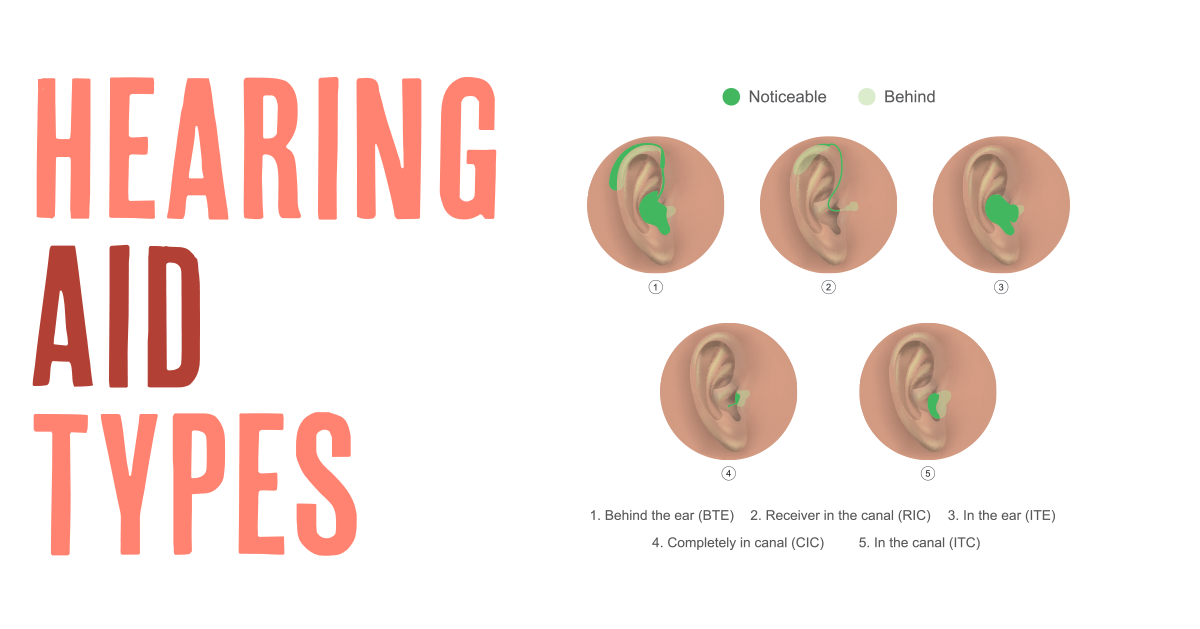
The Audiologist and Audiometrist
The first step is making an appointment and being examined by an audiologist, who will identify the extent and type of your hearing problem.
A full diagnostic hearing assessment is easy, painless and non-invasive. The assessment is conducted by a skilled clinician and takes about 30 minutes.
A hearing assessment includes an ear examination and specialised testing to evaluate hearing sensitivity and response to speech. If hearing loss is detected the clinician will guide you through your options.
A hearing assessment should be done in a sound insulated room. Your clinician will ask you questions and examine your ears and then check your ears by playing tones through earplugs or a headset.
Your clinician will explain the hearing assessment results to you and chat about possible solutions, like whether or not hearing devices are needed.
Should hearing aids be required, a clinician will help select the best device.
Hearing aids are complex digital technologies that should be fitted only by qualified, highly trained hearing healthcare professionals. Do not purchase hearing instruments over the Internet, from a catalogue, by mail order or any other indirect means without the direct involvement of a hearing healthcare professional, and without the benefit of face-to-face consultation.
An audiologist typically will have a master's degree or doctorate in audiology.
An audiometrist will have a diploma or bachelor's degree in audiometry.
While an audiologist's qualifications are higher, hearing aid fitting does not constitute a large portion of their training. Those that do fit hearing aids have obtained most of their practical skills through on the job training.
Audiologists often work in hospitals for ear nose and throat specialists in performing complex diagnostic assessments. In recent years they have focussed more on rehabilitation services via the fitting of hearing aids.
An audiometrist is specifically trained in all practical aspects of hearing assessment and correction of hearing loss through amplification. A high percentage of their training is focussed on the fitting of hearing aids. Historically quite a number of audiometrists have commenced their careers manufacturing hearing aids in hearing aid laboratories.
https://www.hearingaidsaustralia.com/index.htm
Researched, Compiled, Composed, Written and Edited by Dr Steve Gration - February 2020
Sources and References
http://www.hearingadvice.com.au/Hearing-Aids/news/NewsArticle.jsp?News_ID=9
"Sudden deafness is more common than we think"
https://www.hearingaidsaustralia.com/Hearing-Aids/news/NewsArticle.jsp?News_ID=27
https://www.hearingaidsaustralia.com/Hearing-Aids/news/NewsArticle.jsp?News_ID=42
https://www.hearingaidsaustralia.com
Tags
Other Articles
05/12/2023 Understanding Body Language In Meetings »
21/11/2023 Slim Hearing Aids »
18/06/2023 Noise and non-hearing health »
12/06/2023 Using Conversation Visual Cues »
03/01/2023 A beginner's guide to Bluetooth »
08/12/2022 The Stigma of Wearing Hearing Aids »
16/08/2022 How to Become a Better Listener »
13/05/2022 Negativity Bias »
22/04/2022 Tinnitus who has it and why? »
14/10/2021 Lost or Damaged Hearing Aids »
20/10/2020 Deep Listening »
08/10/2020 Over-the-Counter hearing aids »
08/09/2020 Hear Better than Anyone in the Room »
12/08/2020 Sound Wavelength and Loudness »
03/03/2020 Localisation - identifying where sound comes from »
17/12/2019 Hearing Better in Meetings »
09/12/2019 Can meditation improve hearing? »
18/11/2019 Over 50s »
30/10/2019 Wireless Hearing Aids »
07/10/2019 Cleaning and Maintaining Hearing Aids »
09/04/2019 What is the process for buying a hearing aid? »
06/02/2019 One Hearing Aid or Two? »
31/01/2019 Hearing Aid Cost Breakthrough 2019 »
29/08/2017 Hearing Aid Future is Here »
09/06/2017 ABC Checkout Warns on Hearing Aid Purchases »
13/04/2017 Listening better in a noisy world »
21/02/2017 Hearing augmentation devices - IQBuds »
08/12/2016 Childrens Hearing Linked to Social Disadvantage »
24/10/2016 Hearing with Less Effort »
25/01/2016 Seven Thousand Ways to Listen »
01/10/2015 Hearing Loss and Dementia »
06/03/2015 Myth: Hearing Aids do not work »
03/12/2014 ABC Background Briefing Hearing Aids »
20/11/2014 Buying a hearing aid for your parents »
17/01/2014 Is Bluetooth making costly Hearing Aids redundant? »
13/01/2014 Research Online and Save »
08/10/2013 Phonak Q10 Hearing Aid Review »
13/05/2013 Is anyone listening to you »
12/04/2013 Hearing Aid Repairs »
05/04/2013 Will I benefit from a hearing aid? »
18/03/2013 Compare Hearing Aids »
13/03/2013 Audiologists are now mobile »
08/03/2013 Hearing and your work prospects »
18/12/2012 Hearing and your baby »
13/12/2012 Occlusion effect when wearing hearing aids »
24/10/2012 Hearing Aid Brands in Australia »
18/10/2012 ReSound Verso »
03/10/2012 Waterproof Hearing Aids »
28/05/2012 Music to your ears »
19/02/2012 Donate hearing aids that are no longer needed »
31/01/2012 An Invisible Hearing Aid »
26/11/2011 Who to see for sudden hearing loss »
03/11/2011 Restore your hearing or use aids »
13/09/2011 Not wearing your hearing aids »
29/08/2011 Audiologists Career Path »
26/08/2011 Bluetooth Hearing Aids »
Hearing Aid Referral
Get the best price and care from our network of professionals
FREE/no obligation
- Great Care
- Major Brands
Hearing Aid Brands in Australia
